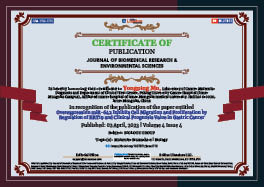Lan Mi, Yu Wu, Xing Wei, Xiaohua He, Xuanping Wang, Shaoheng Li and Yongping Mu*
Volume4-Issue4
Dates: Received: 2023-03-27 | Accepted: 2023-04-02 | Published: 2023-04-03
Pages: 579-589
Abstract
Objective: To investigate the expression of miR-642 in gastric cancer and its mechanism in the proliferation and migration.
Methods: qRT-PCR was used to detect the expression of miR-642 in gastric cancer. Dual luciferase gene reporting system was used to verify the direct regulatory effect of miR-642 on KRT19 3' UTR. The mRNA and protein levels of KRT19 gene after transfection were detected by qRT-PCR and Western blot. The proliferation of miR-642 was detected by IncucyteS long term dynamic cell observation. Kaplan-Meier method was used to analyze the relationship between miR-642 expression level and prognosis in patients with gastric cancer.
Results: The expression of miR-642 in gastric cancer tissues was lower than that in paracancer tissues. The fluorescence intensity of MGC803 cells was significantly decreased after co-transfection of miR-642 mimics and wild-type KRT19-3 'UTR recombinant vector. The expression levels of KRT19 mRNA and protein were significantly decreased after transfected with miR-642 mimics and KRT19 siRNA. Western blot analysis of PTEN, Akt and mTOR proteins showed different expression. Prognostic survival analysis showed that gastric cancer patients with low expression of miR-642 had shorter survival.
Conclusion: miR-642 expression can negatively regulate the target gene KRT19.
FullText HTML
FullText PDF
DOI: 10.37871/jbres1713
Certificate of Publication

Copyright
© 2023 Mi L, et al. Distributed under Creative Commons CC-BY 4.0
How to cite this article
Mi L, Wu Y, Wei X, He X, Wang X, Li S, Mu Y. Overexpression miR-642 Inhibits Cell Migration and Proliferation by Regulation of KRT19 and Clinical Prognosis Value in Gastric Cancer. 2023 Apr 03; 4(4): 579-589. doi: 10.37871/jbres1713, Article ID: JBRES1713, Available at: https://www.jelsciences.com/articles/jbres1713.pdf
Subject area(s)
References
- Xia C, Dong X, Li H, Cao M, Sun D, He S, Yang F, Yan X, Zhang S, Li N, Chen W. Cancer statistics in China and United States, 2022: profiles, trends, and determinants. Chin Med J (Engl). 2022 Feb 9;135(5):584-590. doi: 10.1097/CM9.0000000000002108. PMID: 35143424; PMCID: PMC8920425.
- Machlowska J, Baj J, Sitarz M, Maciejewski R, Sitarz R. Gastric Cancer: Epidemiology, Risk Factors, Classification, Genomic Characteristics and Treatment Strategies. Int J Mol Sci. 2020 Jun 4;21(11):4012. doi: 10.3390/ijms21114012. PMID: 32512697; PMCID: PMC7312039.
- Wei W, Liu C, Yao R, Tan Q, Wang Q, Tian H. miR‑486‑5p suppresses gastric cancer cell growth and migration through downregulation of fibroblast growth factor 9. Mol Med Rep. 2021 Nov;24(5):771. doi: 10.3892/mmr.2021.12411. Epub 2021 Sep 7. PMID: 34490480; PMCID: PMC8436225.
- Zhong Ke, Deng Tianzhi, and Huang Dacui. miRNA-30b regulated ITGB 3 expression and promoted apoptosis in breast cancer cells. Clinical Oncology in China. 2021;48(15):761-766.
- Relative correlation of MicroRNA-30c and prognosis of gastric cancer. Chinese Journal of Cancer Prevention and Treatment. 2014.21 (20): 1598-1601.
- Yoshimura A, Uchino J, Hasegawa K, Tsuji T, Shiotsu S, Yuba T, Takumi C, Yamada T, Takayama K, Hiraoka N. Carcinoembryonic antigen and CYFRA 21-1 responses as prognostic factors in advanced non-small cell lung cancer. Transl Lung Cancer Res. 2019 Jun;8(3):227-234. doi: 10.21037/tlcr.2019.06.08. PMID: 31367536; PMCID: PMC6626854.
- Gwak HK, Lee JH, Park SG. Preliminary evaluation of clinical utility of CYFRA 21-1, CA 72-4, NSE, CA19-9 and CEA in stomach cancer. Asian Pac J Cancer Prev. 2014;15(12):4933-8. doi: 10.7314/apjcp.2014.15.12.4933. PMID: 24998567.
- Walker R, Poleszczuk J, Mejia J, Lee JK, Pimiento JM, Malafa M, Giuliano AR, Enderling H, Coppola D. Toward early detection of Helicobacter pylori-associated gastric cancer. Gastric Cancer. 2018 Mar;21(2):196-203. doi: 10.1007/s10120-017-0748-z. Epub 2017 Jul 19. PMID: 28725964; PMCID: PMC7810132.
- Tang Yunyun, Tang Hailin, Su Qi. The biological role of microRNA in gastric cancer. China. 2014;41(02): 131-133.
- Li S, Sun MY, Su X. MiR-885-5p promotes gastric cancer proliferation and invasion through regulating YPEL1. Eur Rev Med Pharmacol Sci. 2019 Sep;23(18):7913-7919. doi: 10.26355/eurrev_201909_19005. PMID: 31599416.
- Sheng Chunhai, et al. Heat shock protein gp96 3 ′ UTR acting as a ceRNA regulatesbDOHH expression via miR-642a. Biochemistry and Biophysical advances. 2016;43(10): 990-996.
- Nakata B, Takashima T, Ogawa Y, Ishikawa T, Hirakawa K. Serum CYFRA 21-1 (cytokeratin-19 fragments) is a useful tumour marker for detecting disease relapse and assessing treatment efficacy in breast cancer. Br J Cancer. 2004 Aug 31;91(5):873-8. doi: 10.1038/sj.bjc.6602074. PMID: 15280913; PMCID: PMC2409884.
- Wang Z, Zhou H, Cheng F, Zhang Z, Long S. miR-21 Negatively Regulates the PTEN-PI3K-Akt-mTOR Signaling Pathway in Crohn's Disease by Altering Immune Tolerance and Epithelial-Mesenchymal Transition. Discov Med. 2022 Jul-Aug;34(171):45-58. PMID: 36494326.
- The expression and clinical significance of mTOR, and PTEN genes in colorectal cancer tissues. Occupational and Health. 2015;31(08):1041-1044.
- Zhou H, Liu H, Jiang M, Zhang S, Chen J, Fan X. Targeting MicroRNA-21 Suppresses Gastric Cancer Cell Proliferation and Migration via PTEN/Akt Signaling Axis. Cell Transplant. 2019 Mar;28(3):306-317. doi: 10.1177/0963689719825573. Epub 2019 Jan 30. PMID: 30700111; PMCID: PMC6425105.






























































